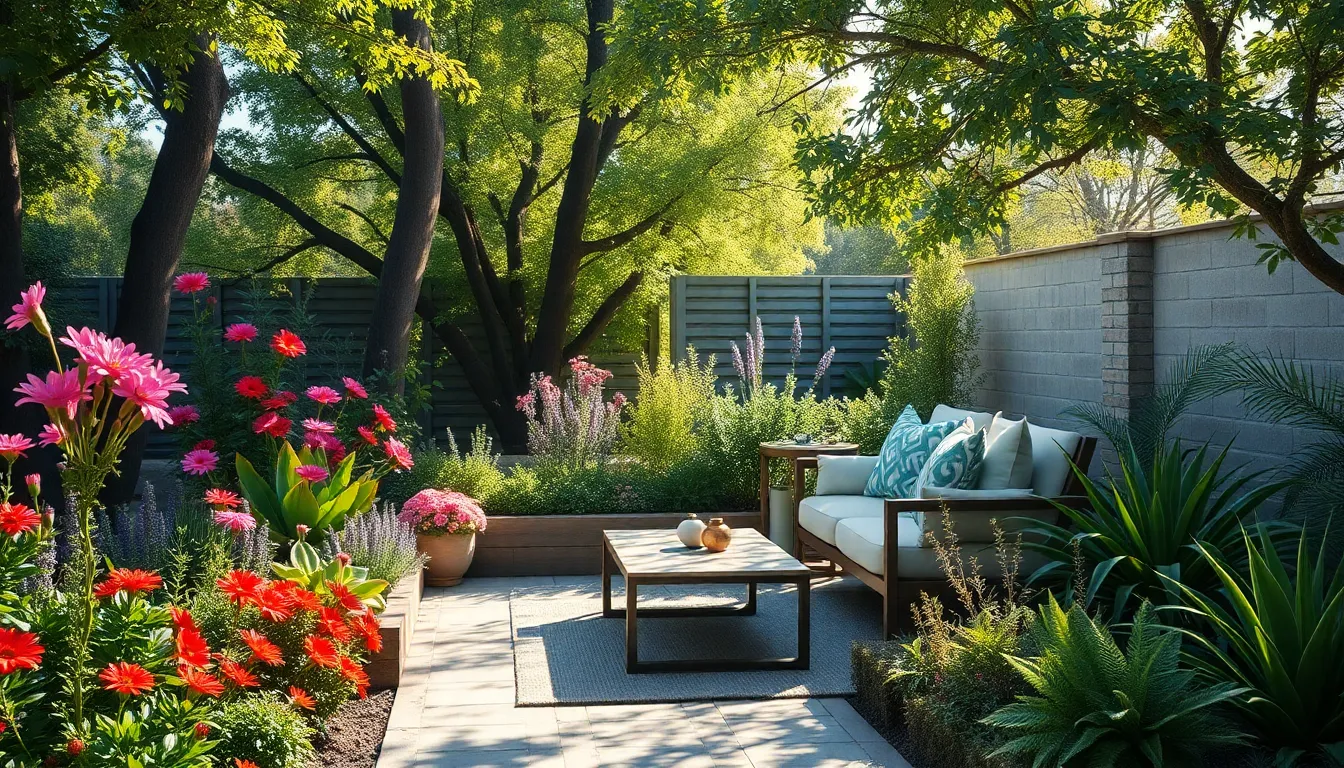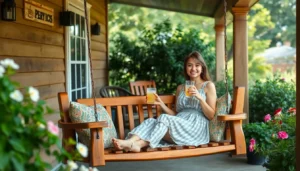Imagine stepping into your backyard and immediately feeling the weight of the world lift off your shoulders. A garden relaxation area isn’t just a luxury; it’s an essential escape from the chaos of everyday life. With a cozy nook surrounded by vibrant blooms and the gentle hum of nature, it’s the perfect spot to sip your morning coffee or indulge in a good book.
Table of Contents
ToggleImportance Of Garden Relaxation Areas
Garden relaxation areas provide essential retreats from daily stress. They promote mental well-being through immersive experiences in nature. A well-designed garden encourages physical activity, enhancing overall health.
The presence of greenery and flowers contributes to a calming atmosphere. Studies show that spending time in natural settings reduces anxiety. Furthermore, sensory experiences from birdsong and rustling leaves amplify relaxation benefits.
Caring for a garden fosters mindfulness and connection to the environment. Engaging in gardening activities has therapeutic effects, offering a sense of accomplishment. That sense of purpose can significantly elevate mood and reduce feelings of loneliness.
Social interactions thrive in garden relaxation areas, facilitating gatherings with family and friends. Shared spaces foster communication and bonding, enhancing relationships. Activities like outdoor dining or yoga can strengthen connections while enjoying the fresh air.
In busy lifestyles, allocating time for relaxation is critical. A garden relaxation area encourages individuals to pause and recharge. Regular breaks in such spaces can lead to improved productivity and creativity.
Plants and natural elements contribute to air quality and eco-friendliness. Incorporating sustainable practices in garden maintenance benefits both the environment and personal well-being.
Naturally, garden relaxation areas serve multiple purposes, from personal retreats to social hubs. Prioritizing space in outdoor environments can elevate quality of life significantly. By creating these areas, individuals invest in their mental and physical health, addressing the daily pressures of modern living.
Designing Your Garden Relaxation Area

Creating a comfortable garden relaxation area involves thoughtful planning. Various factors such as location and plant selection play significant roles in establishing an inviting environment.
Choosing The Right Location
Selecting a serene spot enhances the functionality of a garden relaxation area. It’s crucial to consider sunlight exposure; spaces that receive ample morning light offer warmth without the harsh afternoon sun. Proximity to common gathering areas adds convenience, whether it’s near the house or an outdoor kitchen. Moreover, incorporating natural features like trees or water elements boosts tranquility. Ensuring privacy can transform the area into a personal sanctuary, fostering peace. The right location promotes easy access while creating a seamless transition from the inside to the outside.
Selecting Suitable Plants
Choosing the right plants enriches the sensory experience in a garden relaxation area. Opt for vibrant flowers like lavender or daisies, which not only provide color but also attract pollinators. Foliage plants such as hostas and ferns contribute a lush feel while requiring minimal upkeep. Incorporate fragrant herbs like rosemary or mint to engage the sense of smell. Select native plants that thrive in the local climate for sustainability and ease of care. Combining varied heights and textures creates visual interest while promoting biodiversity. Ultimately, suitable plants enhance relaxation and connect occupants with nature.
Furniture And Accessories For Comfort
Creating a comfortable garden relaxation area includes selecting suitable furniture and accessories. Thoughtful choices enhance the overall experience, making outdoor spaces inviting.
Types Of Seating Options
Chairs and benches serve as essential elements in garden relaxation areas. Lounge chairs provide great support for sunbathing, while hammocks offer a cozy spot for napping. Bean bags create a casual atmosphere, perfect for relaxing moments with family and friends. For a touch of elegance, consider adding wrought-iron furniture, which blends well with natural surroundings. Opting for weather-resistant materials ensures durability against elements. Additionally, incorporating cushions in various colors enhances comfort and aesthetics.
Adding Shade And Shelter
Shade structures, such as pergolas or umbrellas, significantly improve outdoor comfort. They protect from harsh sunlight while creating a cozy atmosphere. Planting trees strategically can offer natural shade and contribute to cooling the area. Adding canopy tents provides shelter for unexpected weather conditions, making it viable for year-round use. Fabric drapes or outdoor curtains also create a sense of privacy and comfort. When relaxation areas include diverse shade options, they create inviting spaces that encourage extended enjoyment.
Creating Ambient Atmosphere
Creating an ambient atmosphere enhances the garden relaxation experience. Proper lighting and water features significantly contribute to this calming environment.
Lighting Ideas For Relaxation
Lighting plays a crucial role in setting a soothing ambiance. String lights offer a cozy, inviting glow, perfect for evening relaxation. Solar lanterns provide eco-friendly illumination while highlighting pathways. Solar-powered garden lights accentuate plant features, creating a magical effect after sunset. Softly lit lanterns can also create focal points among foliage, encouraging exploration. Dimmer switches on built-in fixtures grant flexibility, adjusting brightness to suit different moods. Incorporating candles enhances intimacy, especially during gatherings. Using colored lights strategically can elevate the garden’s overall aesthetic, infusing vibrancy into the space.
Incorporating Water Features
Water features bring tranquility and a sense of serenity to garden relaxation areas. Fountains produce gentle sounds, masking noise and adding to the peaceful atmosphere. Small ponds attract wildlife, enriching biodiversity while providing visual interest. Installing a bubbling water bowl creates a soothing focal point for contemplation. Rills offer a subtle movement of water, enhancing sensory experiences with sight and sound. The reflective surface of water adds depth, making the area feel more expansive. Integrating aquatic plants can enhance aesthetics while improving water quality. Consistent maintenance ensures water features remain clean and attractive, providing lasting enjoyment.
Maintenance Tips For Garden Relaxation Areas
Maintaining a garden relaxation area ensures its beauty and effectiveness as a peaceful retreat. Regular tasks include watering plants adequately to support their growth and appearance. Fertilizing plants provides essential nutrients, enhancing the vitality of flowers and foliage.
Cleaning pathways and furniture contributes to the overall aesthetic and comfort of the space. Keeping weeds at bay prevents competition for resources, leading to healthier plants. Inspecting garden furniture for wear and tear helps maintain a welcoming environment.
Pruning plants specifically encourages healthy growth and removes dead foliage. Mulching around plant bases retains moisture and regulates soil temperature. Checking irrigation systems for leaks or blockages ensures consistent watering.
Replacing plants that do not thrive maintains the visual appeal of the relaxation area. Seasonal planting can introduce variety, keeping the garden engaging throughout the year. Regularly assessing light exposure guarantees that plants receive the right amount of sun.
Incorporating natural pest control methods reduces chemical use, promoting an eco-friendly environment. Observing wildlife interactions fosters a balanced ecosystem, enriching the garden’s biodiversity. Finally, setting a maintenance schedule, with tasks broken down seasonally, keeps the garden consistently inviting.
Engaging with the garden regularly fosters a deeper connection to nature, enhancing the overall therapeutic benefits of the relaxation area.
Creating a garden relaxation area is more than just an aesthetic choice; it’s a vital investment in personal well-being. These spaces offer a sanctuary where individuals can escape the chaos of daily life and reconnect with nature. By thoughtfully designing and maintaining these areas, they become not only a source of peace but also a catalyst for social interactions and physical activity.
The benefits extend beyond personal enjoyment, contributing to a healthier environment and promoting biodiversity. As individuals cultivate their gardens, they foster a deeper appreciation for nature while enhancing their mental and emotional health. Embracing the tranquility of a well-designed garden relaxation area can truly elevate one’s quality of life.


